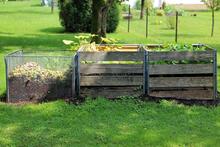URBANA, Ill. – If you haven’t touched your compost bin or pile all winter, don’t worry, you are not alone!
“Getting your compost pile going after the long, cold winter can be intimidating, but it is possible with a little bit of time and careful management,” says Gemini Bhalsod, University of Illinois Extension horticulture educator.
For a successful compost pile, assess your starting point, manage the inputs, then begin turning for a hot pile in no time. The first step is to check to see how your compost pile or bin is doing.
“Be sure to see if there have been any unintended additions over the winter, such as large branches or trash,” Bhalsod says. It is also important to check if any parts of your bin are broken, wood is cracked, or plastic is broken. Make any necessary repairs.
Determine if any of the pile is still active or if it froze through. “Active compost piles produce heat,” Bhalsod says. “So you might see some finished compost at the bottom or middle of the pile, or you might notice some steam coming off the pile.”
If you notice either of these things, your compost is likely still cooking!
Turning the compost pile will require effort. Use a pitchfork to mix the materials and incorporate air into your pile. Composting is a recipe: the beneficial organisms that do the work, with the right combination of air, water, carbon, and nitrogen. "Your goal is to provide the perfect home for these organisms to do their work so you can get compost at the end of the process," Bhalsod says.
After the winter thaw, compost piles are likely to be wet and soggy. If wet, don’t add water, just turn it. If your pile is dry, consider adding water to get it moist.
Add brown and green carbon and nitrogen-source material to the pile. In general, add three-parts carbon material to one-part nitrogen. Bhalsod recommends adding three buckets of brown material to every bucket of greens you add. Some carbon sources include dry leaves, straw, pine needles, and sawdust. Nitrogen sources include fruit and vegetable kitchen scraps, grass clippings, and plant trimmings.
As you continue, monitor your pile. Water it when it is dry and turn it at least once a week. If you follow these steps, your compost pile should be working again in no time.
News source/writer: Gemini Bhalsod, Horticulture Educator, Illinois Extension
